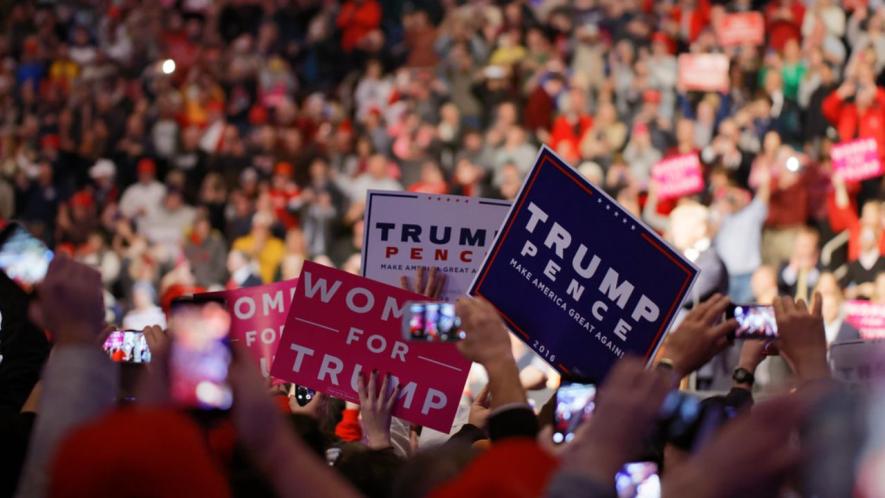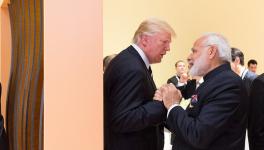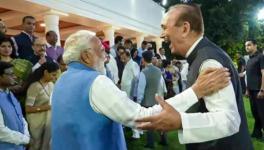Trump’s 2025 Tariff War Folly

Image Courtesy: Flickr
In April 2025, Donald Trump’s administration launched what it termed a “Liberation Day” for American manufacturing, imposing sweeping tariffs on many countries and proclaiming the ostensible return of industrial “sovereignty.” A blanket 10% import tariff was announced, with punitive reciprocal rates as high as 50% for key trading partners, notably China, Vietnam, and South Africa. The rationale was familiar: reduce the trade deficit, bring jobs back home, and punish countries accused of “unfair trade practices.”
But the policy, despite its nationalist theatre, quickly unravelled as a contradiction-laden, politically motivated gamble that was based on an inadequate appreciation of the contemporary reality of a multipolar world. Therefore, it was not entirely unsurprising that Trump “paused” and moderated his tariffs on almost all countries, with the ostensible exception of China. This was followed by tariff exemptions for various types of imported commodities crucial to US monopoly capital. Trump’s tariff war folly had a theoretical dimension and an organisational one. Let’s examine both.
The Poverty of Trumpian Theory and Its Foundations
In mainstream economics, the theory of international trade and open economy macroeconomics are expounded in textbooks and taught to students separately, though they refer to the same reality of the world economy. The question of why there are two theories to study the same reality is not raised as often as it should be.
This theory of international trade, in its simplest textbook version, involves two countries producing through “perfectly” competitive firms the same two consumption goods. Their mutual trade, given their immobile endowments of non-produced inputs, demand patterns, and technological profiles, determines how much of each consumer good is produced and traded by each country.
“Free” trade can make both countries better off in terms of consumption since they can move to a better position relative to a no-trade world. After all, if such trade makes even one country worse off, it could result in that country preferring autarky to trade. Needless to say, both countries experienced full employment during autarky and in a trading world in these theories of international trade. In other words, both countries, according to the theory of international trade, relatively specialise in the production of those commodities in which they have a comparative advantage.
There have been many refinements of this theory of international trade to relax its many unrealistic assumptions, including trade in inputs, mobility of capital and labour, and incorporating “imperfect” competition. But the full incorporation of “imperfect” competition in international trade theory has not been undertaken since the mathematical (or logical) problems in formulating a full theory of general equilibrium with imperfect competition are insurmountable. However, most such modifications of the theory of international trade retain the feature that there is full employment both during autarky and trade, though the sectoral composition of employment does change due to trade. Policy options available in this theory include tariffs and taxes.
Open economy macroeconomics typically involves consideration of a world economy where output has been aggregated. The magnitude of aggregate output tends to be determined by demand (solely in the short run, according to mainstream open economy macroeconomics) in all countries. Additionally, exchange rates are determined by the interaction of the capital and current accounts of the balance of payments.
Here, too, a distinction is made between small open economies, whose actions do not influence world prices, and large open economies, whose actions do influence world prices. Policy options available in this theory include monetary policy, fiscal policy, and tariff policy.
What is not available in mainstream economics is a composite framework about economies in the world where both the sectoral composition of output and the magnitude of aggregate output are jointly determined by the mediation of money, both as a medium of exchange and as a store of value.
Such a composite framework is important because it conforms to what is the case in international political economy. Moreover, such a composite framework also dispenses with the implicit assumption in the theory of international trade and much of open economy macroeconomics that the economies of the world are symmetric and usually differ only in the magnitude of variables involved, such as demand, capital stock, labour force, technology, etc.
Let us consider three such factors that characterise the asymmetric world economy. One, the fact that the US dollar is the international reserve currency is due to various factors in the international political economy that involve vital differences between the US economy and other economies in the world.
Two, primary commodities are principally available from countries of the Global South for reasons of geography; but metropolitan capital has, through the process of imperialism, disproportionately extracted such commodities at prices that relatively stabilise the exchange value of money while relatively deflating incomes in the Global South.
Three, China has, by the third decade of the 21st century, comprehensively ascended the technological ladder that pertains to global production networks and is, therefore, mostly not dependent on technology transfer from the metropolis.
In this context, why was the Trump administration unaware that changes in tariff policy would not only alter prices and the sectoral composition of output but also the magnitude of aggregate output and exchange rates, including the solidity of the status of the US dollar as the international reserve currency?
At one level, the reality that Trump and his administration are intellectually challenged is proffered as an explanation. Therefore, the Trump administration failed to adequately appreciate the importance of a composite approach to the world economy that we previously discussed.
Trump distinguishes himself from most past US presidents in that he is quite likely unaware of being intellectually challenged. However, most past US presidents have been well known for being intellectually challenged, and that did not significantly stand in the way of the effectiveness of government policies.
In fact, the theories of international trade and mainstream open economy macroeconomics were apologies for US imperialist hegemony. When monopoly capital and governments of other countries were arm-twisted by US monopoly capital and its government, the theories of international trade and mainstream open economy macroeconomics provided ideological cover that made this arm-twisting either opaque or appear benign. Recall how voluntary export restraints by Japan with respect to the US were meant to be benign for Japan in the 1970s and 1980s.
More recently, cosmopolitan neoliberals are currently arguing that Trump’s tariff war is a golden opportunity to reduce tariffs, thereby increasing the competitive efficiency of firms in the Indian economy.
What has changed this time is that US imperialist hegemony has diminished. It is no longer possible for US monopoly capital and its government to get governments of all countries to do its bidding through behind-the-scenes maneouvres while foregrounding the apologetics of mainstream open economy macroeconomics and the theory of international trade. That explains both Trump’s brashness (i.e., the full break from the vocabulary of the Washington Consensus and the transition to “Make America Great Again” or MAGA) and its diminished effectiveness.
Financial Shock and the Treasury Unwind
The economic blowback to Trump’s tariff war was immediate. In the days following the tariff announcement, US financial markets experienced a rare trifecta: falling stock prices, a weakening dollar, and a steep rise in Treasury yields. The trigger was the collapse of the “basis trade,” a complex but widely used arbitrage strategy in the bond market. Hedge funds caught in the unwind were forced to sell large volumes of US government debt, pushing yields up and sending shockwaves through the financial system.
Why did this happen? Trump claimed bond market agents became queasy but he did not say why. Unlike Trump’s MAGA base, US monopoly capital and its key constituent, the corporate-financial oligarchy, have a reasonably fair estimate of the actual array of forces in the international political economy. This estimate is informed by the leverage that China can exert on the US government. US monopoly capital correctly expected that Trump’s tariff war would increase domestic inflation, which would cause the US Federal Reserve to raise the policy interest rate.
The US Federal Reserve found itself trapped. With inflation still elevated and global appetite for US debt waning, it could not easily intervene without risking further price instability. This exposed a deeper vulnerability: the assumption that US Treasuries would always be a safe haven for international rentiers. There was speculation that at least some foreign governments sold part of their holdings of US Treasuries. Therefore, when demand for US Treasuries fell below its supply, the prices of US Treasuries fell, which increased their yield (defined as the ratio of the coupon rate of a given US Treasury bond divided by the price of that bond). This increase in yield would, over time, impart upward pressure on the entire spectrum of interest rates in the US economy, with unavoidable deflationary consequences. Consequently, what began as a tariff war quickly escalated into a crisis of US imperialist hegemony. This compelled Trump to retreat.
Tariff Pause, Strategic Exemptions, Global Production Networks
To begin with, Trump paused higher tariffs on almost all countries, except China, for 90 days, ostensibly to finalise trade negotiations. In other words, Trump’s retreat was sought to be given a face-saving guise of the art of a deal. Then, the tariffs on China were increased, with the ostensible rationale to drive a wedge between China and other foreign countries. But this ignored the extent to which Chinese firms dominate almost all reaches of the technological ladder that pertains to global production networks. Therefore, within hours of the announcement of Trump’s tariff pause, exemptions on tariffs on imports of various electronic goods, including smartphones and processors, were announced.
The terminology of exemptions makes it appear that this was a concession granted by the US government to Chinese and other foreign firms. In fact, such exemptions were an acknowledgment that the US economy, and particularly big tech, including Apple, cannot afford tariff-induced shocks given the current array of power between China and US monopoly capital and its state.
Once again, to save face, these exemptions were presented as transitional measures by the Trump administration. But in truth, US firms rely not just on finished goods that are directly or indirectly from China, but also on rare earths, critical components, and complex global production networks dominated by China but spanning the world, especially selected parts of the Global South. The notion that a tariff wall can swiftly recreate this entire ecosystem within the US is economic fantasy.
Trade Protectionism Without a Plan?
Tariffs can, in principle, serve a useful purpose, buying time for domestic industries to first engage in import substitution and then move on to exports, given a favorable array of power in the international political economy. But in the absence of a broader industrial policy, tariffs by themselves amount to little more than economic theatre and wishful thinking. Such tariffs will merely intensify the squeeze on the working people in the US that began decades ago. Trump offered no coherent industrial strategy. There were no plans for reskilling workers, incentivising capital investment, or reorganising supply chains.
Worse, the economic conditions in the US are hardly conducive to industrial resurgence:
● Mechanisation limits employment growth even if production returns.
● Skilled labour shortages are worsened by anti-immigrant policies.
● Health, education, and housing costs undermine competitive pricing.
● Financial capital continues to dominate investment priorities.
Most crucially, sustained full employment, if somehow achieved through reindustrialisation, would contradict the neoliberal project of maintaining the stability of the exchange value of money via precarisation and wage suppression. Monopoly capital will not willingly jeopardise its control by enabling mass employment.
China Responds—With Structural Advantage
China’s response was swift and multidimensional. Apart from reciprocal tariffs, it implemented export controls on rare earth minerals—vital for US tech and defence sectors. But more significantly, it advanced its financial sovereignty. The yuan is increasingly used in bilateral trade, currency swaps are expanding, and alternative financial infrastructure is being developed. China’s diplomatic outreach also gained traction.
The BRICS bloc is strengthening financial cooperation, African trade integration is accelerating, and discontented US client states are re-evaluating their allegiances. All this is made possible by China’s structural position in the world economy. Unlike the US, it is not hostage to complex, over-financialised supply chains or dependent on foreign capital inflows to prop up its currency.
Decline of US Imperialist Hegemony
Trump’s tariff misadventure has made visible the accelerating decline of US imperialist hegemony. His overtures to Russia and punitive measures against China are signs of desperation, not strength. Cosmopolitan neoliberals try to blame Trump’s personality alone, ignoring that these failures stem from broader shifts in global power. Trump is reckless and ideologically hollow. But even a more “rational” president would be unable to reverse the underlying erosion of US dominance. Global production networks, once centered around US capital, now are are more dispersed with China playing a leading role.
What Next?
The Trump administration, anxious to save face, wants China to make the first move to initiate negotiations. Cosmopolitan neoliberals work towards the same objective by calling on the Chinese government to be the adult in the room. But China is unlikely to oblige given the contemporary array of power in the international political economy. The Chinese expectation seems to be that negotiations be initiated by the US, since Trump had initiated the trade war.
In an attempt to reframe its trade war as a national security imperative, the Trump administration released a factsheet on April 15, 2025, announcing a Section 232 investigation into US reliance on imported processed critical minerals and their derivative products. The document asserts that such dependence poses risks to national security and economic resilience, citing China’s dominance in the supply of these materials.
However, this approach overlooks the structural realities of global production networks. The US currently lacks the infrastructure to process many critical minerals domestically, and building such capacity would require significant time and investment. Imposing tariffs without addressing these underlying issues may exacerbate supply chain vulnerabilities rather than mitigate them.
Furthermore, the factsheet’s emphasis on China’s export restrictions fails to acknowledge that such measures are often responses to US trade policies. By portraying China as the sole aggressor, the administration ignores the reciprocal nature of trade relations and the potential for collaborative solutions.
In essence, the administration’s strategy appears to be a continuation of its protectionist policies under the guise of national security. Without a comprehensive plan to develop domestic processing capabilities and diversify supply sources, these measures risk further isolating the US from global markets and weakening its economic position.
It is possible that the Trump administration becomes further aware of its limitations through further rounds of lobbying by various segments of US monopoly capital, resulting in further exemptions from tariffs on imports to the US. The longer the Trump administration delays initiating negotiations with China, the greater will be the pace of the relative decline of US monopoly capital.
Shirin Akhter is Associate Professor at Zakir Husain Delhi College, University of Delhi. C Saratchand is Professor, Department of Economics, Satyawati College, University of Delhi. The views are personal.
Get the latest reports & analysis with people's perspective on Protests, movements & deep analytical videos, discussions of the current affairs in your Telegram app. Subscribe to NewsClick's Telegram channel & get Real-Time updates on stories, as they get published on our website.
























